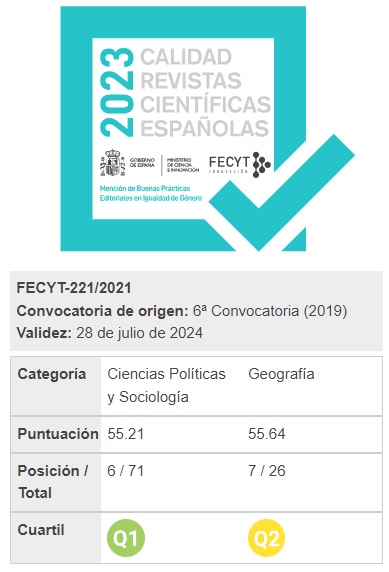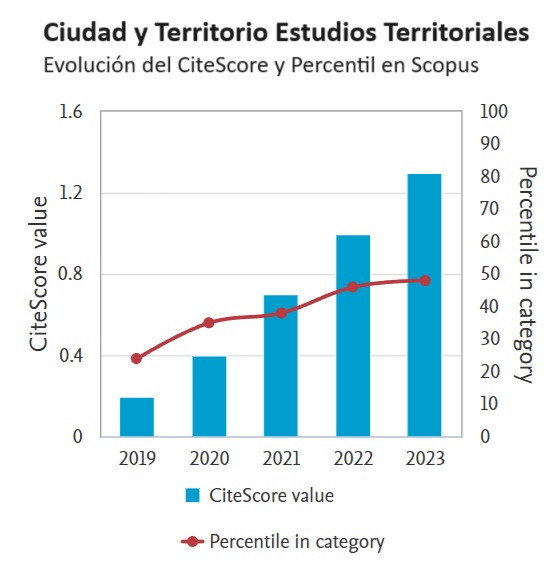New paradigms of the unfinished city: the reactivation of abandoned spaces through temporary uses
DOI:
https://doi.org/10.37230/CyTET.2022.214.1Keywords:
Temporary uses, Urban voids, Temporary city, Disused buildingsAbstract
The large number of derelict buildings in most European cities requires a specific response for their incorporation into new life cycles. The reactivation of these pieces, strategically necessary to trigger urban regeneration processes, is often conflictive with urban planning. Faced with this problem, weighed down by the economic-financial crisis, flexible processes of building reactivation are being tested through temporary uses that provide a response to the "meanwhile" situation. Far from being incompatible with planning, these processes can be seen as a complementary system, which should have a regulatory framework that allows its insertion into traditional urban planning.
Downloads
References
Abarrategui, A. & Burgués, I. (2016): Análisis de oportunidades para la consideración de los espacios en transición. Bilbao, España, Gobierno Vasco
Amendola, G. (2015): “I cento colori del vuoto”. En Intorno al vuoto, ed. Cambi, A., Miselli R. (ed). Rovereto, Italia, List Lab
Ballesteros, P. (2006): Arquitectura reactiva. Arquitectos, nº179, pp.96-101
Barberis, V. & Sandven, H. (coord.) (2019): Sustainable & Circular RE-Use of spaces & buildings. Handbook. Urban Agenda Paternship on Sustainable Use of Land and Nature-Based Solutions
Bauman, Z. & Bordoni, C. (2016): Estado de Crisis. Barcelona, España, Paidós
Bishop, P. & William, L. (2012): The Temporary City. London, New York, Routledge
Bowman, A. & Pagano, M. A. (2004): Terra incognita: Vacant land and urban strategies. Washington DC, EEUU, Georgetown University Press
Bürgin, M. & Cabane, P. (1999): Akupunktur für Basel: Zwischennutzung als Standortentwicklung auf dem Areal des DB_Güterbahnhofs in Basel. Basilea, Suiza, Urbane Strategien Projektentwicklung Kommunikation
Cámara, C. (2018): Comunes urbanos: Lecciones desde la Barcelona de principios de siglo XXI. Una propuesta de caracterización desde la praxis. Tesis doctoral, Universitar Oberta de Catalunya
Dalmau i Torvá, m. (2014): Can Batlló: de la degradación planificada a la construcción comunitaria. Quaderns-e, nº19 (1), pp. 143-159
De Certeau, M. (2007): La invención de lo cotidiano. México, Universidad Iberoamericana
Dzokic, A. & Neelsen, M. & Kievity, I. (2010): Constituting the ‘Interim’. Rotterdam, Paises Bajos, Catja Edens
Ferreri, M. (2015): The Seductions of Temporary Urbanism. Ephemera. Theory and Politics in Organization. Vol. 15(1), pp.181-191
Galdini, R. (2020): Temporary uses in contemporary spaces. A European project in Rome. Cities, vol. 96. https://doi.org/10.1016/j.cities.2019.102445
Gastaldi, F. & Camerin, F. (2017): La regeneración urbana en Italia a partir de la reutilización del patrimonio público inmobiliario: un catálogo de herramientas y protocolos, Ciudades, n.20, pp.155-178
Grávalos Lacambra, I. & Di Monte, P. (2014): La reprogramación de la ciudad: consideraciones urbanas y sociales en torno al programa “estonoesunsolar”, Ciudad y Territorio. Estudios territoriales, nº179, pp.127-137. https://recyt.fecyt.es/index.php/CyTET/article/view/76294
Harvey, D. (1977): Urbanismo y desigualdad social. Madrid, España, Siglo XXI
Jacobs, J. (2011): Muerte y vida de las grandes ciudades. Madrid, España, Capitán Swing
Lacol (ed.) (2014): Inventari de Can Batlló. Teixint una histórica col.lectiiva. Barcelona, España, Secretariat d’Entitats de Sants, Hostafrancs i La Bordeta
Lehtovuori, P. & Ruoppila, S. (2012): Temporary uses as means of experimental Urban Planning, SAJ. Serbian Architecture Journal, nº4, pp.29-54
Lloret, P. (2015): “Nuevas formas de gobernanza en los espacios públicos. Casos de estudio para la ciudad de Amsterdam y Barcelona”. En de la Riva, J. & Ibarra, P. & Rodríguez, M. (eds). Análisis espacial y representación geográfica. Innovación y aplicación, Zaragoza, Universidad de Zaragoza
Luque, E. & Pascual, A. (2014): “Bricolador”. En Valero, E. (dir) Glosario de reciclaje urbano. Valencia, España, General de ediciones de arquitectura.
Lydon, M. & García, A. (2015): Tactical urbanism: Short-term action, long-term change. Washington, D.C, EEUU, Island Press
Lynch, K. (1995): “The posible city”. En Barnejee, T. & Southworth, M. (eds.). City Sense and City Design: writings and projects of Kevin Lynch, Cambridge, Mit Press
Mangialardo, A. & Micelli, E. (2018): From sources of financial values to commons: Emerging policies for enhancing public real-estate assets in Italy. Papers in Regional Science, vol. 97, n.4, pp.1397-1408
Marra, G. & Barosio, M. & Eynard, E. & Marietta, C. (2016): From urban renewal to urban regeneration: Classification criteria for urban intereventions. Turín 1995-2015: Evolution of planning tools and approaches. Journal of Urban Regeneration and Renewal, vol. 9 (4), pp.367-380
Marrades Sempere, R. (2016): “Activación de los espacios vacíos, las claves de una oportunidad para la economía urbana”. En Fernández González, M. et al. El uso temporal de los vacíos urbanos. Barcelona, Diputación de Barcelona
Marzot, N. (2015): Il concetto di Bene Comune e le pratiche di uso temporaneo. Urbanistica Informazione, nº 263, pp.12-16
Monte, P. Di & Lenna, V. (ed) (2022): Tools for the Generative Commons. Practices, processes and design. Saint Gilles, Bélgica, Generative Commons House
Muñoz, F. (2016): “El vacío urbano y la ciudad interrumpida. Para una geografía urbana de los tiempos muertos”. En Fernández,M. & Gifreu, J. El uso temporal de los vacíos urbanos, Barcelona, Diputación de Barcelona
Newman, G. & Smith, A. & Brody, S. (2017): Repurposing Vacant Land through Landscape Connectivity. Landscape Journal nº 36:1, pp. 37-57
Newman, G & Park, Y. & Bowman, A. & Lee, R. (2018): Vacant urban areas: Causes and interconnected factors. Cities, vol.72, pp. 421-429
Oswalt, P. & Overmeyer, K. & Misselwitz, P. (2004): Urban Catalyst. Strategies for temporary use. Berlín, Alemania, Dom Publishers
Oswalt, P. & Overmeyer, K. & Misselwitz, P (2013): Urban Catalyst. The Power of temporary use. Berlín, Alemania, Dom Publishers
Overmeyer, K. (2007): Urban Pioneers. Temporary Use and Urban Development in Berlin. Berlin, Alemania, Jover
Pagano, M. A. & Bowman, A. O. M. (2000): Vacant land in cities: An urban resource. Washington, DC, Brookings Institution, Center on Urban and Metropolitan Policy
Patti, d. & Polyak, l. (2015): From practice to policy: Frameworks for temporaary use. Urban Research and Practice, vol. 8 (1), p.1
Rowe, C. &; Koetter, F. (1998): Ciudad Collage. Barcelona, España, Gustavo Gili
Scheffler, N. (2018): 2nd Chance. Waking Up the “Sleeping Giants”. An Urban Guidebook for the reactivation and reuse of larger vacants building. Programme Urbact
Sennett, R. (2019): Construir y habitar. Ética para la ciudad. Barcelona, España, Anagrama
Smith, N. (1996): The New Urban Frontier. New York, EEUU, Routledge
Solá-Morales, I. (1996): Terrain Vagues. Quaderns d’arquitectura i urbanisme, nº 212, pp.34-43
Spataro, D. (2016): Againts a de-depolitized DIY urbanism: Food not bombs and the struggle over public space. Journal of Urbanism, nº 9, pp.185-201
Stevens, Q. (2018): Temporary uses of urban spaces: How are they understood as ‘creative’? ArchNet-IJAR: International Journal of Architectural Research, vol. 12, nº 3, pp.90-107
Published
How to Cite
Issue
Section
License
Copyright (c) 2022 IGNACIO GRÁVALOS LACAMBRA

This work is licensed under a Creative Commons Attribution-NonCommercial-NoDerivatives 4.0 International License.
Considering the provisions of the current legislation on Intellectual Property, and in accordance with them, all authors publishing in CyTET give -in a non-exclusive way and without time limit- to the Ministry of Transport, Mobility and Urban Agenda the rights to disseminate, reproduce, communicate and distribute in any current or future format, on paper or electronic, the original or derived version of their work under a Creative Commons Attribution-NonCommercial-NoDerivative 4.0 license International (CC BY-NC-ND 4.0), as well as to include or assign to third parties the inclusion of its content in national and international indexes, repositories and databases, with reference and recognition in any case of its authorship.
In addition, when sending the work, the author(s) declares that it is an original work in which the sources that have been used are recognized, committing to respect the scientific evidence, to no longer modify the original data and to verify or refute its hypothesis. Author(s) also declare that the essential content of the work has not been previously published nor will it be published in any other publication while it is under evaluation by CyTET; and that it has not been simultaneously sent to another journal.
Authors must sign a Transfer of Rights Form, which will be sent to them from the CyTET Secretariat once the article is accepted for publication.
With the aim of promoting the dissemination of knowledge, CyTET joins the Open Journal Access (OA) movement and delivers all of its content to various national and international indexes, repositories and databases under this protocol; therefore, the submission of a work to be published in the journal presupposes the explicit acceptance by the author of this distribution method.
Authors are encouraged to reproduce and host their work published in CyTET in institutional repositories, web pages, etc. with the intention of contributing to the improvement of the transfer of knowledge and the citation of said works.








 Enlace a CyTET en Linkedin
Enlace a CyTET en Linkedin